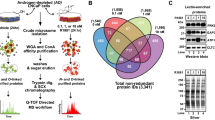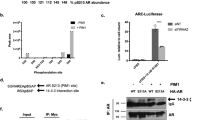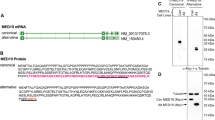Abstract
The epidermal growth factor receptor and androgen receptor (AR) both play major roles in the control of prostate growth. Our hypothesis is that shared downstream components of these two signaling pathways are significant participants in androgen-independent growth. Our first objective was to identify proteins whose activation and/or expression in AR-positive prostate epithelial cells are induced by both epidermal growth factor (EGF) and dihydrotestosterone (DHT). AR expression was induced in a tumorigenic, metastatic subline of the SV40 large T-antigen immortalized human prostate epithelial subline M12 by stable transfection with human wild-type AR cDNA. These M12AR (+) cells with functional AR were treated in parallel with EGF (10 ng/ml) or DHT (10−8 M) for 24 h before 2D gel electrophoresis and Western immunoblotting with antiphosphotyrosine monoclonal antibody. Coomassie blue-stained spots on a 2D gel run in parallel were aligned with the phosphoproteins on the Western immunoblot, and identified by matrix-assisted laser desorption ionization/time-of-flight mass spectroscopy. The most interesting of the seven proteins that appeared to be phosphorylated by these criteria was 14-3-3 protein sigma. Protein extracted after either EGF or DHT treatment, immunoprecipitated with antiphosphotyrosine monoclonal antibody, and immunoblotted by anti-14-3-3 sigma confirmed phosphorylation of 14-3-3 sigma. Addition of either DHT or EGF to the M12AR(+) cells induced subcellular migration of 14-3-3 sigma and activated a 14-3-3 sigma reporter construct. Immunohistochemical analysis revealed nuclear localization of 14-3-3 sigma in higher Gleason grade prostate cancers relative to benign glands. These findings implicate 14-3-3 sigma in the development of human prostate cancer cells and could provide a new target for intervention in prostate cancer.
This is a preview of subscription content, access via your institution
Access options
Subscribe to this journal
Receive 50 print issues and online access
$259.00 per year
only $5.18 per issue
Buy this article
- Purchase on Springer Link
- Instant access to full article PDF
Prices may be subject to local taxes which are calculated during checkout








Similar content being viewed by others
References
Abreu-Martin MT, Chari A, Palladino AA, Craft NA and Sawyers CL . (1999). Mol. Cell. Biol., 19, 5143–5154.
Bae VL, Jackson-Cook CK, Brothman AR, Maygarden SJ and Ware JL . (1994). Int. J. Cancer, 58, 721–729.
Bae VL, Jackson-Cook CK, Maygarden SJ, Plymate SR, Chen J and Ware JL . (1998). Prostate, 34, 275–282.
Balk SP . (2002). Urology, 60 (3 Suppl 1), 132–138.
Brunet A, Kanai F, Stehn J, Xu J, Sarbassova D, Frangioni JV, Dalal SN, DeCaprio JA, Greenberg ME and Yaffe MB . (2002). J. Cell Biol., 156, 817–828.
Chan TA, Hermeking H, Lengauer C, Kinzler KW and Vogelstein B . (1999). Nature, 401, 616–620.
Culig Z, Hobisch A, Cronauer MV, Radmayr C, Trapman J, Hittmair A, Bartsch G and Klocker H . (1994). Cancer Res., 54, 5474–5478.
El Sheikh SS, Domin J, Abel P, Stamp G and Lalani el-N . (2003). Neoplasia, 5, 99–109.
Ferguson AT, Evron E, Umbricht CB, Pandita TK, Chan TA, Hermeking H, Marks JR, Lambers AR, Futreal PA, Stampfer MR and Sukumar S . (2000). Proc. Natl. Acad. Sci. USA, 97, 6049–6054.
Gygi S, Corthal S, GL, Zhang Y, Rochon Y and Aebersold R . (2000). Proc. Natl. Acad. Sci. USA, 97, 9390–9395.
Haendler B, Schuttke I and Schleuning WD . (2001). Mol. Cell. Endocrinol., 173, 63–73.
Hermeking H, Lengauer C, Polyak K, He TC, Zhang L, Thiagalingam S, Kinzler KW and Vogelstein B . (1997). Mol. Cell, 1, 3–11.
Kino T, Souvatzoglou E, De Martin MU, Tsopanomihalu M, Wan YH and Chrousos GP . (2003). J. Biol. Chem., 278, 25651–25656.
Laronga C, Yang HY, Neal C and Lee MH . (2000). J. Biol. Chem., 275, 23106–23112.
Liu X, Wu Y, Zehner Z, Jackson-Cook C and Ware JL . (2003). Electrophoresis, 24, 3445–3453.
Martel CL, Gumerlock PH, Meyers FJ and Lara PN . (2003). Cancer Treat. Rev., 29, 171–187.
Myers RB, Oelschlager D, Manne U, Coan PN, Weiss H and Grizzle WE . (1999). Int. J. Cancer, 82, 424–429.
Orio Jr R, Terouanne B, Georget V, Lumbroso S, Avances C, Siatka C and Sultan C . (2002). Mol. Cell. Endocrinol., 198, 105–114.
Osada H, Tatematsu Y, Yatabe Y, Nakagawa T, Konishi H, Harano T, Terzel E, Takada M and Takahashi T . (2002). Oncogene, 21, 2418–2424.
Peterziel H, Mink S, Schonert A, Becker M, Klocker H and Cato AC . (1999). Oncogene, 18, 6322–6329.
Plymate SR, Tennant MK, Culp SH, Wooke L, Marcelli M, Colman I, Nelson PS, Carroll JM, Roberts Jr CT and Ware JL . (2004). Prostate. (in press).
Subramanian RR, Masters SC, Zhang H and Fu H . (2001). Exp. Cell Res., 271, 142–151.
Torring N, Dagnes-Hanse F, Sorensen BS, Nexo E and Hynes NE . (2003). Prostate, 56, 142–149.
Tzivion G and Avruch J . (2002). J. Biol. Chem., 277, 3061–3064.
van Hemert MJ, Steensma HY and van Heusden GP . (2001). BioEssays, 23, 936–946.
Vercoutter-Edouart AS, Lemoine J, Bourhis X, Louis H, Boilly B, Nurcombe V, Revillion F, Peyrat JP and Hondermarck H . (2001). Cancer Res., 61, 76–80.
Yaffe MB . (2002). FEBS Lett., 513, 53–57.
Zilliacus J, Holter E, Wakui H, Tazawa H, Treuter E and Gustafsson JA . (2001). Mol. Endocrinol., 15, 501–511.
Acknowledgements
We thank Dr B Vogelstein (Johns Hopkins University) for providing the 14-3-3 sigma promoter luciferase construct and Dr T Kino (NIH, Bethesda, MD, USA) for providing the GFP-fused 14-3-3 sigma plasmid. We thank Ms Gwen Langston for sectioning the prostate tissue microarrays for us. This work was supported in part by NIDDK RO1 DK52683 (JLW and SRP).
Author information
Authors and Affiliations
Corresponding author
Rights and permissions
About this article
Cite this article
Huang, D., Liu, X., Plymate, S. et al. Proteomic identification of 14-3-3 sigma as a common component of the androgen receptor and the epidermal growth factor receptor signaling pathways of the human prostate epithelial cell line M12. Oncogene 23, 6881–6889 (2004). https://doi.org/10.1038/sj.onc.1207788
Received:
Revised:
Accepted:
Published:
Issue Date:
DOI: https://doi.org/10.1038/sj.onc.1207788



